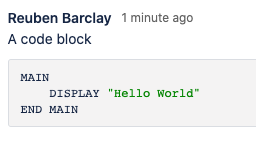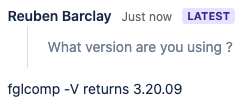Ask Reuben – October 28, 2020
Portal Etiquette
When raising cases in portal, how can I indicate code?
When raising cases in portal, how can I quote text?
At the online conference towards the end of last year, Lionel Fluck from our Technical Support Center in Strasbourg, France did a presentation (pdf, video) titled Dealing With Support. Part of that covered the markdown syntax you can use when commenting in the support portal. The two important ones to remember are {code} and {quote}.
You can use {code} to indicate code, this uses a monospace font so any code alignment is maintained. It also stops any other markdown syntax from occurring so I find it handy to use with configuration (.xcf) and log file snippets (.log) as well or else you may find characters being lost as they are interpreted as markdown syntax
A code block
{code}
MAIN
DISPLAY "Hello World"
END MAIN
{code}
Similarly {quote} can be used to quote text. So you might respond to a question by quoting the question you are answering e.g.
{quote}
What version are you using ?
{quote}
fglcomp -V returns 3.20.09
When these are viewed by us and in the portal then it reads …
It is hoped that the tool we use will one day make it more intuitive on how you can use this markdown syntax and other syntax.
There are a few other things that improve the usage of the portal that Lionel commented on and I’d like to reiterate those.
Don’t be afraid to create multiple cases to deal with multiple issues. If you consolidate multiple issues in one case then it is quite possible for these minor individual issues to be lost as we focus on one particular issue. The support team have the ability to clone a case so that each issue can be dealt with separately. If your case is cloned like this, this is the reason why.
One benefit of having the portal is that we can search through the portal to see if the issue has been raised previously. This benefit is lost if you type everything up in a PDF or Word document and attach to the case as the search doesn’t look inside the .pdf / .docx files. I would encourage you to type directly into the portal rather than attaching a document.
Similarly screenshots and recordings are encouraged but note these can also sometimes be typed into the portal. For example error dialogs and code samples are better typed (or copied and paste from GDC, GBC, Studio or your terminal emulator) rather than taking a screenshot. Again this facilitates search and also facilitates our copying and pasting of code to try and create an example.
Finally when creating mcve, or sending samples these scenarios can and do occur …
- no database schema file included but code has DATABASE or SCHEMA statement. We can’t compile the sample or we have to go through and edit sources to make them formonly or explicit datatypes.
- no .rdd included for use with .4rp, makes it difficult to view and edit the .4rp
- DATABASE or CONNECT statement connecting to your database. Unless we have your database, the sample program will stop. Best technique if database required is to utilise the in-memory database and have your sample create and populate database tables.
- example refers to your library functions that are not included in your sample, the sample program will not compile.
- example makes use of your modified default.4st, default.4ad that are loaded by default. Our attempts to reproduce will use the standard default.4st etc
Finally if you can test with the latest versions. (and of course tell us the versions you are using) then that can save some analysis investigating an issue that has already been resolved.
On our side of the coin, there are two common mistakes we make. When dealing with issues, we need to use a URL that refers to the Issue Tracker e.g. https://4js.com/support/issue/?id=FGL-05449. Occasionally we will give you …
- a URL that refers to our internal system FGL-5449 instead of the case in the issue tracker. If you think we have done that, you can edit the URL to point to the issue tracker
- the correct URL in the Issue Tracker but fail to mark the issue as public. In that case you have to let us know to change the flag from the default private value so that you can read it.
So to wrap up, back to the original topic, {quote} and {code} is the markdown syntax you should remember to use in the portal to make the cases easier to read for you and our team.



